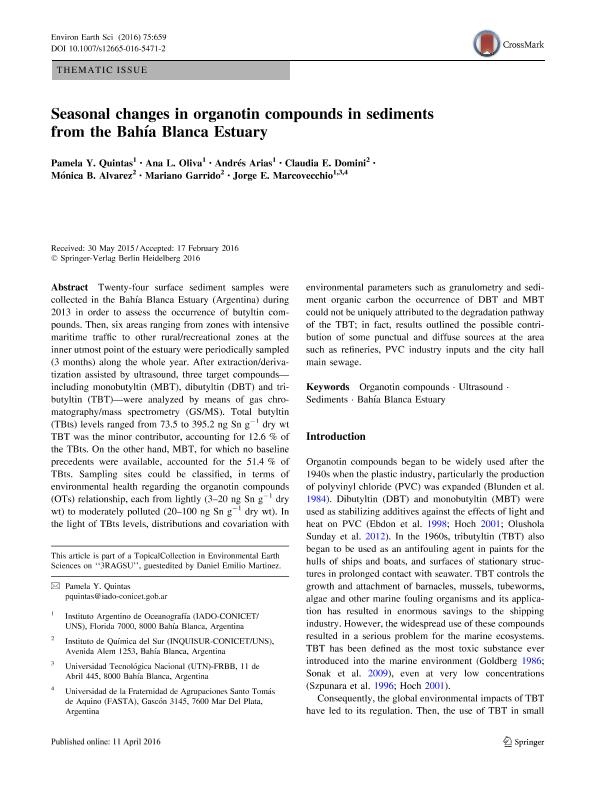Artículo
Seasonal changes in organotin compounds in sediments from the Bahía Blanca Estuary
Quintas, Pamela Yanina ; Oliva, Ana Laura
; Oliva, Ana Laura ; Arias, Andres Hugo
; Arias, Andres Hugo ; Domini, Claudia Elizabeth; Álvarez, Mónica Beatriz; Garrido, Mariano Enrique
; Domini, Claudia Elizabeth; Álvarez, Mónica Beatriz; Garrido, Mariano Enrique ; Marcovecchio, Jorge Eduardo
; Marcovecchio, Jorge Eduardo
 ; Oliva, Ana Laura
; Oliva, Ana Laura ; Arias, Andres Hugo
; Arias, Andres Hugo ; Domini, Claudia Elizabeth; Álvarez, Mónica Beatriz; Garrido, Mariano Enrique
; Domini, Claudia Elizabeth; Álvarez, Mónica Beatriz; Garrido, Mariano Enrique ; Marcovecchio, Jorge Eduardo
; Marcovecchio, Jorge Eduardo
Fecha de publicación:
04/2016
Editorial:
Springer
Revista:
Environmental Earth Sciences
ISSN:
1866-6280
Idioma:
Inglés
Tipo de recurso:
Artículo publicado
Clasificación temática:
Resumen
Twenty-four surface sediment samples were collected in the Bahı´a Blanca Estuary (Argentina) during 2013 in order to assess the occurrence of butyltin compounds. Then, six areas ranging from zones with intensive maritime traffic to other rural/recreational zones at the inner utmost point of the estuary were periodically sampled (3 months) along the whole year. After extraction/derivatization assisted by ultrasound, three target compounds— including monobutyltin (MBT), dibutyltin (DBT) and tributyltin (TBT)—were analyzed by means of gas chromatography/mass spectrometry (GS/MS). Total butyltin (TBts) levels ranged from 73.5 to 395.2 ng Sn g-1 dry wt TBT was the minor contributor, accounting for 12.6 % of the TBts. On the other hand, MBT, for which no baseline precedents were available, accounted for the 51.4 % of TBts. Sampling sites could be classified, in terms of environmental health regarding the organotin compounds (OTs) relationship, each from lightly (3–20 ng Sn g-1 dry wt) to moderately polluted (20–100 ng Sn g-1 dry wt). In the light of TBts levels, distributions and covariation with environmental parameters such as granulometry and sediment organic carbon the occurrence of DBT and MBT could not be uniquely attributed to the degradation pathway of the TBT; in fact, results outlined the possible contribution of some punctual and diffuse sources at the area such as refineries, PVC industry inputs and the city hall main sewage.
Palabras clave:
Bahía Blanca Estuary
,
Organotin Compounds
,
Sediments
,
Ultrasound
Archivos asociados
Licencia
Identificadores
Colecciones
Articulos(IADO)
Articulos de INST.ARG.DE OCEANOGRAFIA (I)
Articulos de INST.ARG.DE OCEANOGRAFIA (I)
Citación
Quintas, Pamela Yanina; Oliva, Ana Laura; Arias, Andres Hugo; Domini, Claudia Elizabeth; Álvarez, Mónica Beatriz; et al.; Seasonal changes in organotin compounds in sediments from the Bahía Blanca Estuary; Springer; Environmental Earth Sciences; 75; 4-2016; 659-672
Compartir
Altmétricas



